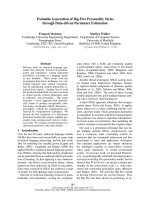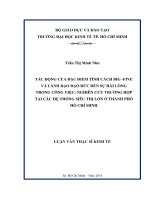BIG FIVE” PERSONALITY
Bạn đang xem bản rút gọn của tài liệu. Xem và tải ngay bản đầy đủ của tài liệu tại đây (65.25 KB, 5 trang )
A. INTRODUCTION
The Big-Five model is widely used around the world to help define
participants' personalities or personality types (show and hide), thereby
understanding themselves better, living and working happier work (Zhang &
Ziegler, 2016). Additionally, enhancing personality is linked to academic or
professional success, so everyone needs to overcome their personality's
negative aspects and improve the positive ones. The purpose of this study was
to look into the relationship between nature and self-improvement, as well as
how self-improvement promotes self-motivation in situations when success is
desired. This essay is organized into five sections: introduction, overview,
personality test results, and lastly, the article's conclusions and resources.
B. “BIG FIVE” PERSONALITY
There is a range between two extremes for each of the five primary
personality traits. People's personality traits reflect their characteristic patterns
of thinking, feeling, and behavior. Therefore, trait psychology focuses on the
idea that individuals differ from one another in terms of fundamental traits
that endure over time. Some precise characteristics of human traits include
selfishness, honesty and hard-working (Imiton, 2020). The Big Five
Personality has five factors to summarize the aspects of a person's personality,
and they are known as the prominent five personality characteristics:
•
Extroversion:
Extroverts tend to be communicative and
assertive and are often interested in exciting elements such as color, sound,
and movement (Allport, G. W., & Odbert, H. S., 1936). Extroverts are easy to
approach, often interested in their surroundings, and are always optimistic and
enthusiastic. An extrovert likes and becomes energized when in large groups,
and alone time is less enjoyable and boring for them. People with low
extroversion are less outgoing and more comfortable working independently.
•
Agreeableness: A person with high agreeableness is likely to
show trust, altruism, kindness, and affection. Prosocial behavior is more
likely exhibited by highly agreeable individuals, which means they are more
likely to impact others around them positively. They often have a favorable
attitude toward human nature and get along well with others. Individuals with
a low level of agreeableness may prioritize their own interests over the
interests of others, and their demeanor is frequently disconnected, hostile, and
disagreeable.
•
Conscientiousness: Conscientiousness is one of the Big Five
personality traits that indicate the proclivity to be responsible, organized,
hard-working, goal-oriented, and obedient to rules and conventions. A quality
characterized by responsibility, dependability, persistence, and being wellorganized. Low Conscientiousness individuals favor having fun and
responding to the moment's demands over being conscientious (Feher &
Vernon, 2021). Relaxed, laid-back, and casual are common descriptions of
them. The rigid structure of schedules and schedules that are too demanding
tend to annoy them. Planning is complex for
those
with low
Conscientiousness. As a result of their tendency to follow their impulses, they
may have difficulty achieving long-term goals.
•
Emotional Stability: Among its positive traits are calmness, self-
assurance, and security under stress, while negative features include
nervousness, depression, and insecurity.
•
Openness to Experience:
A person who is open to new
experiences will usually like venturing outside of their regular realm of
familiarity. Conversely, people with low openness to new experiences will
retreat into familiar environments.
C. TWO AREAS FOR SELF-IMPROVEMENT
Many studies suggest that two things shape a person's personality:
biology (heredity) and living environment. These two elements play a crucial
part in the formation of each of the Big Five. It demonstrates that while a
person's personality features can change, his personality does not. An
extrovert will always be extroverted, but with time and life experience, the
extroverted personality will manifest at a deeper, more typical level. We
should address behaviors that have an excessive or insufficient impact on
personality traits, allowing individuals to understand themselves better and
live happier lives. As a result, working on oneself will yield specific results in
the learning process and future work.
•
Agreeableness:
Because of my low score of 5 in this area, sometimes it is challenging
to gain more beliefs and forgive mistakes. An improvement in agreeableness
is needed so that people will be more supportive and friendly to me. I will try
to listen to people's opinions and care about their feelings to understand their
lives and problems better. I sometimes avoid other people's concerns, which
keeps them distant and forms an invisible barrier in their relationship with me.
Therefore, becoming enthusiastic, friendly, and willing to cooperate are
fundamental goals to build relationships and achieve future success at
university and at work.
•
Conscientiousness
I am a clear example of a Low Conscientiousness individual, scoring
7, showing that I do not use my time effectively and have a specific plan for
long-term goals. I used to lack dedication at work and changed jobs many
times. I considered, "If you do something every day, it will easily be boring
someday." So I changed my mind quickly and was impatient with a long-term
plan. So I set a goal of controlling how I spend my time, so I can prioritize
what's important and focus my energy when needed. From there, I form good
habits and don't waste my time and energy with distractions. With that, I need
to avoid distraction because it reduces productivity, increases stress levels,
and makes it harder to achieve goals. By improving my ability to concentrate,
I will be able to raise my work standards and focus clearly on my
responsibilities, improving my grades and ability to complete the job.
D. CONCLUSION:
The Big-Five model is widely used around the world to assist
individuals to define their personalities or personality types (visible and
hidden). From there, you may better understand yourself and live and work
happier. Through studying the five factors in the "Big five", it can be
concluded that an individual with a high score in agreeableness and
conscientiousness and a low score in neuroticism will be more likely to
succeed in their lives. The author also realized that it is necessary to develop
two factors, "Agreeableness" and "Conscientiousness" to get along with
people and reduce stress at work. Therefore, good time management, practical
working, enthusiastic mindset, and willingness to cooperate with colleagues
will help me succeed in the future.
REFERENCE LIST
Zhang, J., & Ziegler, M. (2016). How do the big five influence
scholastic performance? A big five-narrow traits model or a double mediation
model.
Learning
And
Individual
Differences,
50,
93-102.
/>Imiton, M. (2020). Students’ Value-Belief-Norm (VBN) Model
Interfered by Environmental Big-Five Personality. Journal Of Advanced
Research
In
Dynamical
And
Control
Systems,
12(SP8),
197-202.
/>Allport, G. W., & Odbert, H. S. (1936). Trait-names: A psycho-lexical
study.
Psychological
Monographs,
47(1),
i–171.
/>Feher, A., & Vernon, P. (2021). Looking beyond the Big Five: A
selective review of alternatives to the Big Five model of personality.
Personality And Individual Differences, 169, 110002. />j.paid.2020.110002
/>









